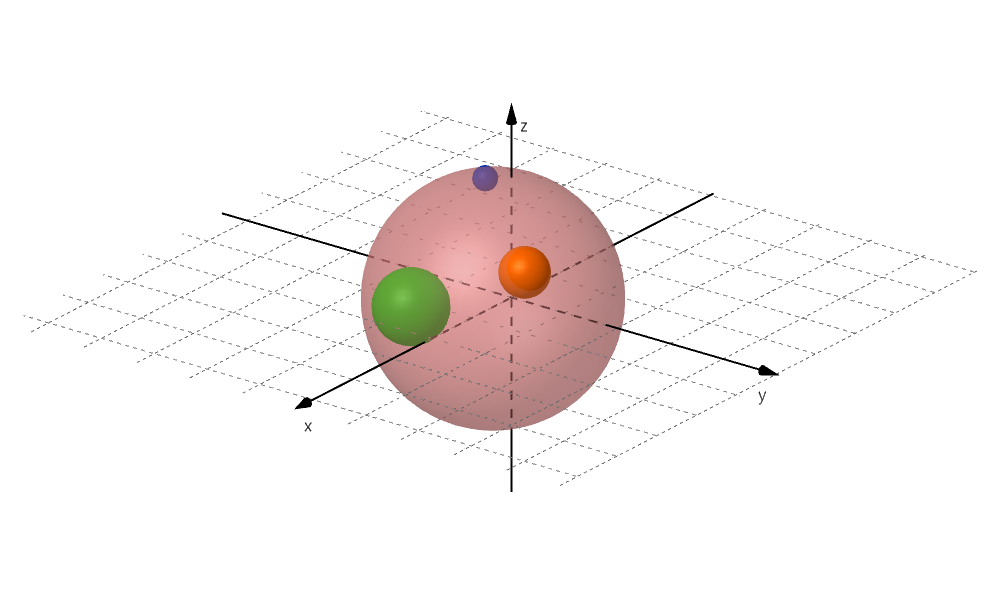H. Cosmic Cleaner
Description:
在一片小行星带里有 n 颗小行星,它们在万有引力的作用下绕着一颗行星旋转。在这一刻时,它们之间不存在碰撞的情况。一位清洁工奉命前来清理这颗行星,Ta 会动用某种先进技术使这颗行星顷刻间从宇宙中消失,任何距离这颗行星的中心在一定范围内的事物都会在一瞬间被清除。假设这些天体都是完整的球体,你能计算出清除的区域里有多少体积的事物原本属于这些小行星吗?
注意,这些天体在此刻满足两两不存在交集的条件。
下图是对样例的解释,其中清理区域是标记为红色的球体内部,而小行星则被依次标记为橙色、蓝色和绿色。
Input:
输入包含多组测试数据。第一行包含一个整数 T ,表示测试数据的组数。随后的内容是各组测试数据。对于每组测试数据:
第一行包含一个整数 n。
接下来的 n 行里,每行包含四个整数 x,y,z 和 r ,表示有一颗中心位于 (x,y,z)、半径为 r 的小行星。
最后一行包含四个整数 x′,y′,z′和r′ ,表示行星的中心位于 (x′,y′,z′) ,而清洁工的清理半径为 r′(一个大于该行星半径的值)。
- 1≤T≤6000
- 1≤n≤100
- −103≤x,y,z,x′,y′,z′≤103
- 1≤r,r′≤103
Output:
对于每组测试数据,输出一行Case #x: y,其中x是测试数据的编号(从 1 开始编号),y是这组数据的答案,要求相对误差或绝对误差不超过 10−6。
严格来讲,如果你的答案是 a,而标准答案是 b,那么当 max1,∣b∣∣a−b∣≤10−6 时你的答案会被认为是正确的。
Sample Input:
1
3
5 5 5 2
-6 -7 6 1
6 -5 0 3
1 -1 0 10
Sample Output:
Case #1: 142.76246874761383764962
题目链接
计算一球与其余 n 个球的球交体积。
计算球交的重点在于球缺的计算,推荐一篇详解博客(现场赛我也是现学的这篇博客…雾)
两圆相交到两球相交
AC代码:
#include <bits/stdc++.h>
using namespace std;
const int maxn = 1e2 + 5;
const double pi = acos(-1.0);
const double eps = 1e-8;
int Sgn(double X) {
if (fabs(X) < eps) {
return 0;
}
return X < 0 ? -1 : 1;
}
struct Point {
double X, Y, Z;
void Input() {
scanf("%lf%lf%lf", &X, &Y, &Z);
}
};
typedef Point Vector;
Vector operator + (Vector Key1, Vector Key2) {
return (Vector){Key1.X + Key2.X, Key1.Y + Key2.Y, Key1.Z + Key2.Z};
}
Vector operator - (Vector Key1, Vector Key2) {
return (Vector){Key1.X - Key2.X, Key1.Y - Key2.Y, Key1.Z - Key2.Z};
}
double operator * (Vector Key1, Vector Key2) {
return Key1.X * Key2.X + Key1.Y * Key2.Y + Key1.Z * Key2.Z;
}
double Length(Vector Key) {
return sqrt(Key * Key);
}
double operator ^ (Vector Key1, Vector Key2) {
return Length((Vector){Key1.Y * Key2.Z - Key1.Z * Key2.Y, Key1.Z * Key2.X - Key1.X * Key2.Z, Key1.X * Key2.Y - Key1.Y * Key2.X});
}
double DisPointToPoint(Point Key1, Point Key2) {
return sqrt((Key1 - Key2) * (Key1 - Key2));
}
struct Sphere {
Point Center;
double Radius;
void Input() {
Center.Input();
scanf("%lf", &Radius);
}
};
double CalVolume(Sphere Key) {
return 4.0 / 3.0 * pi * Key.Radius * Key.Radius * Key.Radius;
}
double SphereIntersectVolume(Sphere Key1, Sphere Key2) {
double Ans = 0.0;
double Dis = DisPointToPoint(Key1.Center, Key2.Center);
if (Sgn(Dis - Key1.Radius - Key2.Radius) >= 0) {
return Ans;
}
if (Sgn(Key2.Radius - (Dis + Key1.Radius)) >= 0) {
return CalVolume(Key1);
}
else if (Sgn(Key1.Radius - (Dis + Key2.Radius)) >= 0) {
return CalVolume(Key2);
}
double Length1 = ((Key1.Radius * Key1.Radius - Key2.Radius * Key2.Radius) / Dis + Dis) / 2;
double Length2 = Dis - Length1;
double X1 = Key1.Radius - Length1, X2 = Key2.Radius - Length2;
double V1 = pi * X1 * X1 * (Key1.Radius - X1 / 3.0);
double V2 = pi * X2 * X2 * (Key2.Radius - X2 / 3.0);
return V1 + V2;
}
int T;
int N;
Sphere Planet[maxn];
Sphere Clean;
double Ans;
int main(int argc, char *argv[]) {
scanf("%d", &T);
for (int Case = 1; Case <= T; ++Case) {
scanf("%d", &N);
for (int i = 1; i <= N; ++i) {
Planet[i].Input();
}
Clean.Input();
Ans = 0.0;
for (int i = 1; i <= N; ++i) {
Ans += SphereIntersectVolume(Clean, Planet[i]);
}
printf("Case #%d: %.20lf\n", Case, Ans);
}
return 0;
}





 京公网安备 11010502036488号
京公网安备 11010502036488号